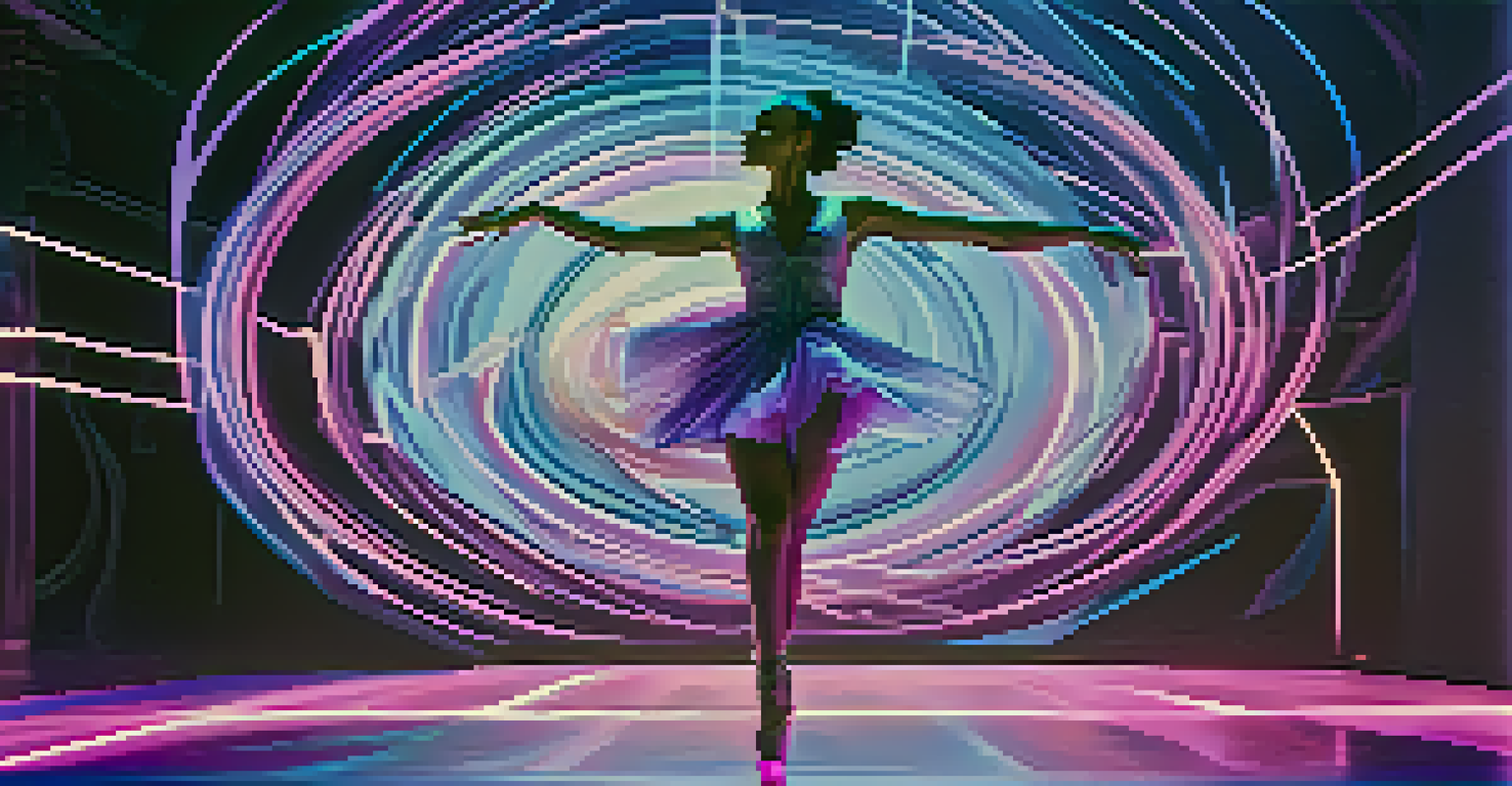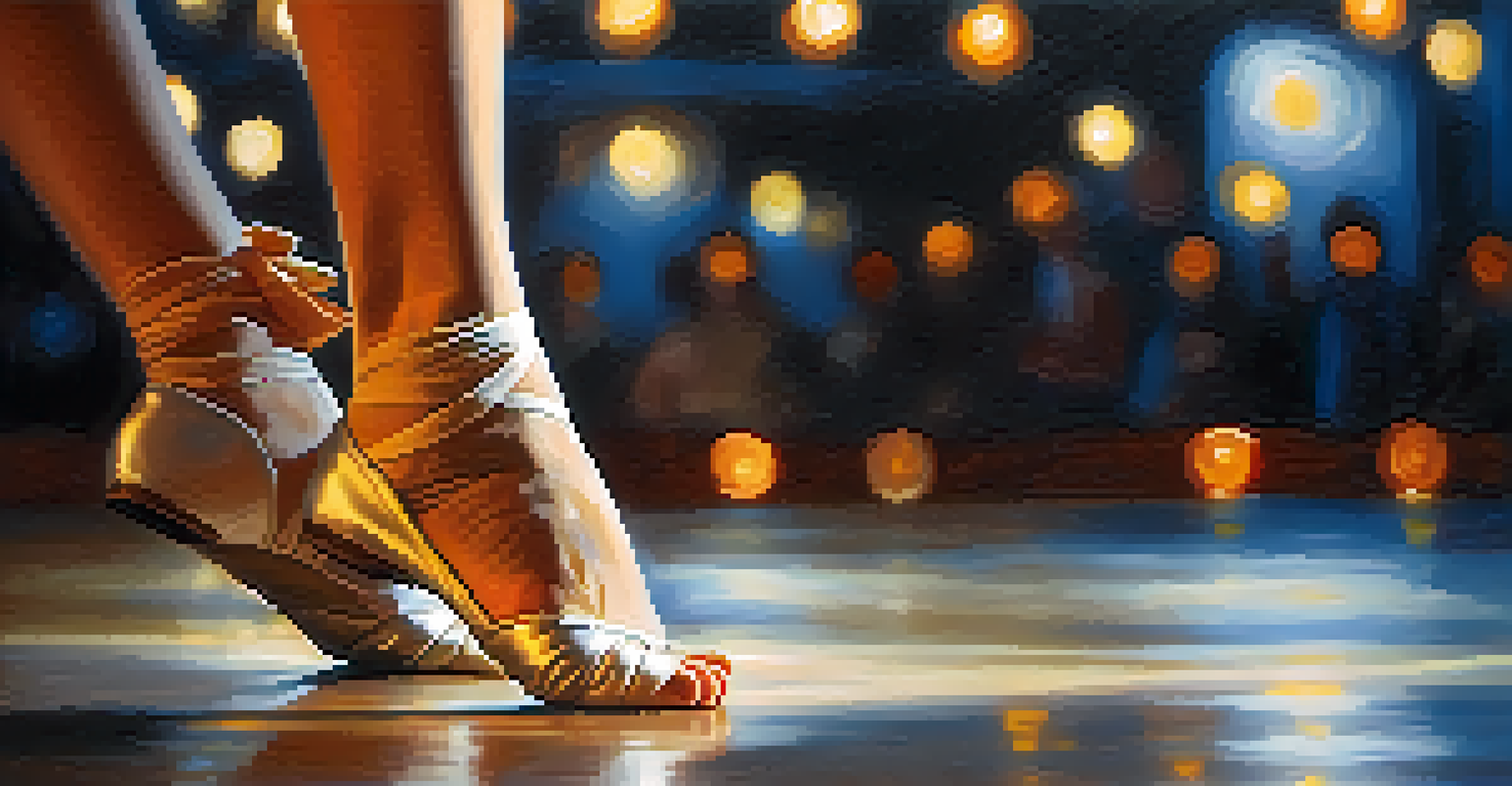The Fusion of Dance and Technology in Storytelling

The Evolution of Dance as a Storytelling Medium
Dance has always been a powerful tool for storytelling, conveying emotions and narratives through movement. From ancient rituals to modern performances, the evolution of dance reflects cultural shifts and societal changes. Today, choreographers are embracing new technologies to enhance their storytelling, creating experiences that resonate with audiences on multiple levels.
Dance is the hidden language of the soul.
Consider how ballet tells stories of love and longing through precise movements, while hip-hop often reflects social issues and personal narratives. As dance evolves, it increasingly interacts with other art forms, particularly technology, to push boundaries and captivate audiences. This merging of disciplines opens up a world of possibilities, enriching the way stories are told.
The integration of technology in dance not only expands the repertoire of movements and expressions but also invites viewers to engage more deeply with the performance. By weaving together traditional techniques with innovative digital tools, artists can create immersive experiences that transport audiences into new narratives.
Technology: The New Partner in Dance
In recent years, technology has become a vital partner in the world of dance, providing new ways to explore movement and narrative. From motion capture to projection mapping, these tools allow choreographers to visualize and experiment with their ideas in ways that were previously unimaginable. This collaboration between dance and technology redefines the boundaries of both art forms, leading to groundbreaking performances.

For instance, motion capture technology enables dancers' movements to be translated into digital avatars, creating a unique blend of real and virtual performances. This not only adds a layer of depth to storytelling but also allows for experimentation with new styles and techniques. Audiences can witness a fusion of live dance and digital artistry, enhancing their overall experience.
Dance Meets Technology for Storytelling
The integration of technology in dance enhances storytelling by creating immersive experiences that resonate with audiences.
Moreover, the use of augmented reality (AR) and virtual reality (VR) can transform traditional dance performances into immersive experiences. Imagine being able to step into a digital world where you can interact with dancers or influence the narrative through your choices. This innovative approach opens up exciting avenues for storytelling in dance, making it more accessible and engaging.
Case Studies: Successful Fusion of Dance and Tech
Numerous projects around the world are exemplifying the successful fusion of dance and technology. One notable example is the performance 'Digital Rain' by the dance company Chunky Move, which uses real-time motion tracking to create stunning visual effects that respond to the dancers' movements. This interactive element not only captivates the audience but also enhances the narrative being told.
Technology is best when it brings people together.
Another exciting project is 'The Nightingale,' a collaboration between choreographer Alexander Ekman and digital artist Magnus Härenstam. This performance combines live dance with immersive digital environments, transporting viewers to a dream-like world. The use of technology in this context allows for a richer storytelling experience, where the environment plays a crucial role in shaping the narrative.
These case studies highlight how the integration of technology can elevate dance performances, making them more dynamic and engaging. By pushing the boundaries of traditional storytelling, these projects encourage other artists to explore the endless possibilities that arise from this fusion.
The Impact of Social Media on Dance Storytelling
Social media platforms have revolutionized the way dance is shared and consumed, providing a global stage for storytellers. Dancers and choreographers use platforms like Instagram and TikTok to showcase their work, reaching audiences far beyond the confines of traditional theaters. This accessibility has led to a new form of storytelling, where dance narratives can be communicated in short, impactful snippets.
Moreover, social media allows for immediate feedback and interaction, enabling artists to engage with their audience in real-time. This connection fosters a sense of community and encourages collaboration among dancers and creators worldwide. As a result, dance storytelling becomes a collective experience, enriched by diverse perspectives and cultural influences.
Social Media Amplifies Dance Narratives
Platforms like Instagram and TikTok allow dancers to share their stories globally, fostering community and collaboration.
Additionally, social media's visual nature complements the art of dance perfectly, as movement and expression can be captured in captivating visuals. This has led to a surge in dance challenges and trends, which often tell stories of empowerment, resistance, or joy. By harnessing the power of social media, dancers can amplify their narratives and reach a wider audience than ever before.
Exploring Interactive Dance Experiences
Interactive dance experiences are at the forefront of merging technology with storytelling. These performances invite audiences to participate actively, transforming passive viewers into engaged participants. This shift not only enhances the storytelling aspect but also creates a memorable and personal connection to the performance.
For instance, immersive theater experiences might allow audience members to choose which path to follow, influencing the narrative direction. In dance, similar concepts can be applied, where viewers might control lighting, sound, or even the dancers' movements through their actions. This level of interactivity adds a new dimension to storytelling, making it unique for each audience member.
These interactive elements encourage audiences to reflect on their own experiences and emotions, making the dance narrative even more resonant. By bridging the gap between performer and viewer, interactive dance experiences foster a deeper understanding of the stories being told, enhancing the overall impact of the performance.
Challenges in Merging Dance and Technology
While the fusion of dance and technology offers exciting possibilities, it also presents unique challenges. One of the primary concerns is the potential for technology to overshadow the dancer's artistry. Striking a balance between digital enhancements and the raw emotion of dance is crucial to maintaining the integrity of the performance.
Moreover, the rapid pace of technological advancements can be daunting for many artists. Keeping up with new tools and platforms requires time and resources, which may not always be available, particularly for independent dancers and choreographers. This can create a divide between those who can afford to invest in technology and those who cannot.
Interactive Experiences Engage Audiences
Interactive dance performances transform viewers into participants, deepening their connection to the narrative.
Lastly, there is the challenge of audience reception. Not all viewers may be ready to embrace the integration of technology into dance, leading to mixed reactions. Educating audiences on the potential of this fusion is essential to fostering appreciation and understanding of the new narratives being presented through this innovative lens.
The Future of Dance and Technology in Storytelling
Looking ahead, the fusion of dance and technology in storytelling is poised to evolve even further. As technology continues to advance, artists will find new ways to incorporate these tools into their work, creating even more immersive and engaging experiences. The future may see the rise of AI-driven choreography or performances that adapt in real-time to audience reactions.
Moreover, as audiences become more familiar with these innovative forms of storytelling, there will likely be an increasing demand for new experiences that blend dance and technology. This shift will encourage artists to push boundaries and experiment with unconventional narratives, ultimately enriching the art form as a whole.

The ongoing dialogue between dance and technology will not only enhance storytelling but also inspire a new generation of artists. By collaborating across disciplines and embracing these advancements, the world of dance is set to flourish, captivating audiences with fresh, dynamic narratives that resonate deeply and authentically.